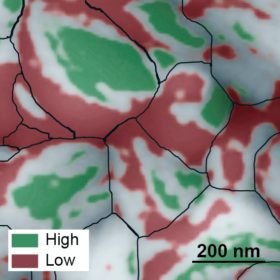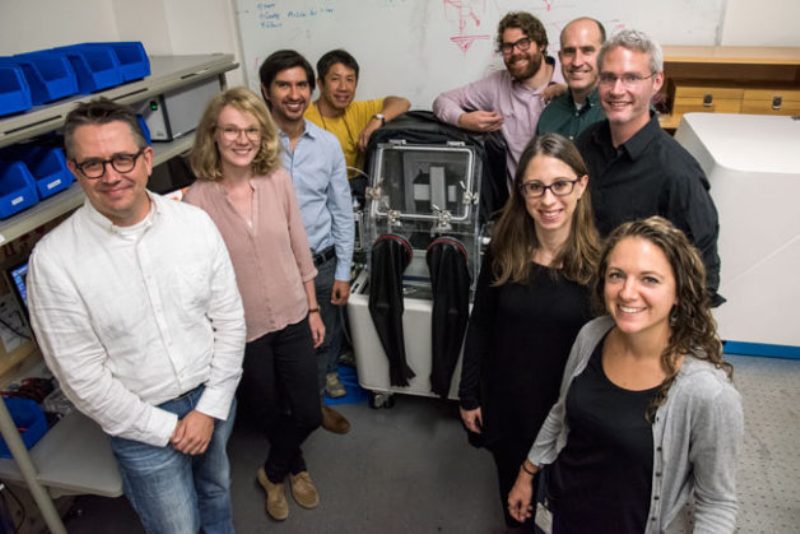With an efficiency increase of 3% in 2009 to up to 22% today, perovskite semiconductors have attracted the attention of PV researchers around the globe. A team from Molecular Foundry and the Joint Center for Artificial Photosynthesis at Berkeley Lab have deployed atomic force microscopy to reveal the “bumpy surface” of a perovskite solar cell, indicating that efficiencies vary widely within the cell dependent on the nature of its surface.
Investigating perovskite solar cells at the nanoscale, the researchers discovered that the cell surface is composed of grains around 200 nanometers. At the nanoscale, the research also revealed that each grain itself has multi-angled facets – like the faces of a gemstone, Berkeley Lab explains in a press release.
The photocurrent generation, and therefore conversion efficiency, of the different facets varies wildly, approaching 31% at the highest end, down to very low efficiency on others. The facets behave like “billions of tiny solar cells, all connected in parallel,” the Berkeley press release elaborates. With current flowing from to the good to the bad cell, the overall efficiency of the material is reduced.

“If the material can be synthesized so that only very efficient facets develop, then we could see a big jump in the efficiency of perovskite solar cells, possibly approaching 31%,” said Sibel Leblebici, a postdoctoral researcher at the Molecular Foundry.
Leblebici and the Berkeley Lab team performed atomic force microscopy analysis of perovskite material produced by researchers at the Center for Artificial Photosynthesis. The technique allowed for the perovskite surface to be mapped at a resolution of ten nanometers, along with the cells’ conversion efficiency, through measuring photocurrent generation and open circuit voltage.
The perovskite cells studied were composed of methylammonium lead iodide and were produced without an electrode layer. Eight half cells were packed onto a 1cm2 substrate.
The microscopy technique revealed that there was a 0.6V difference in open circuit voltage between facets on the same grain within the perovskite cell. Facets with high photocurrent generation exhibited high open circuit voltage, while those with low generation had low open circuit voltage.
“This was a big surprise,” said Alexander Weber-Bargioni, in whose lab Leblebici carried out her research. “It shows, for the first time, that perovskite solar cells exhibit facet-dependent photovoltaic efficiency,” continued Weber-Bargioni.
“These results open the door to exploring new ways to control the development of the material’s facets to dramatically increase efficiency,” added fellow researcher Francesca Toma.
While efficiency gains are certainly encouraging, a major bottleneck to deployment in PV applications of perovskites remains the stability of the promising solar material. While perovskites exhibiting a high conversion efficiency have been produced, they remain prone to pronounced temperature and light-induced degradation. Conversely, more stable perovskite material often has a very low conversion efficiency.
The Berkeley Lab team published the results on Monday in the journal Nature Energy. The research was supported in part by the Department of Energy’s Office of Science.
The August edition of pv magazine will feature an interview with Chris Case, the CTO of perovskite developer Oxford PV.
This content is protected by copyright and may not be reused. If you want to cooperate with us and would like to reuse some of our content, please contact: editors@pv-magazine.com.









1 comment
By submitting this form you agree to pv magazine using your data for the purposes of publishing your comment.
Your personal data will only be disclosed or otherwise transmitted to third parties for the purposes of spam filtering or if this is necessary for technical maintenance of the website. Any other transfer to third parties will not take place unless this is justified on the basis of applicable data protection regulations or if pv magazine is legally obliged to do so.
You may revoke this consent at any time with effect for the future, in which case your personal data will be deleted immediately. Otherwise, your data will be deleted if pv magazine has processed your request or the purpose of data storage is fulfilled.
Further information on data privacy can be found in our Data Protection Policy.